
Italian postcard by Fotocelere, Torino.
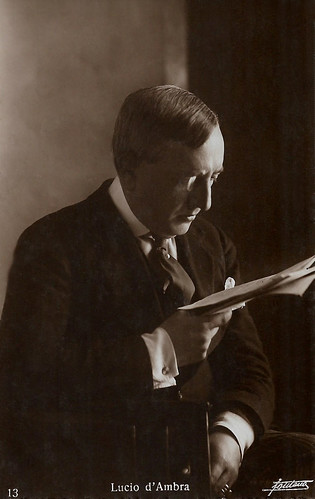
Italian postcard by Ed. A. Traldi, Milano, no. 13. Photo: Fontana.
A delicious Lubitsch-like comedy
Lucio D'Ambra was born Renato Eduardo Manganella in Rome, Italy, in 1879. According to some sources, his full name was Renato Tommaso Anacleto Manganella, and his year of birth was 1880.
D'Ambra was a journalist, literary and theatre critic, playwright and artistic director of theatre companies. Ettore Petrolini reduced his play 'Ambasciatori' to one of his shows. He was also a screenwriter for the cinema, an academic of Italy and an author of novels, including 'I due modi di avere vent'anni' (The Two Ways to be 20), published by Arnoldo Mondadori in 1934. He had the writer and poet Tullio Colsalvatico as his secretary and was in contact with the philosopher and critic Adriano Tilgher, with whom he polemised at length.
D'Ambra was also the animator of a literary salon which allowed him to come into contact with literary figures and personalities from the art world. He was friends with the writer Arturo Olivieri Sangiacomo, the playwright Tito Marrone and the founder of the Bagutta Prize, Marino Parenti. In 1923, he founded a company called Teatro degli Italiani at the Teatro Eliseo in Rome, together with Mario Fumagalli and Santi Severino. The aim of the company, subsidised by the Fascist regime to promote theatre in Italy, but with little success.
In 1911, he entered the cinema writing a screenplay of 'I promessi sposi' (The Betrothed) for the film of the same name by Ugo Falena. In 1913, he wrote the script for the film Il bacio di Cirano/The Kiss of Cyrano (Carmine Gallone, 1913) starring Soava Gallone. It was Carmine Gallone's debut film as a director. In 1916 D'Ambra started to work steadily in the cinema as a screenwriter for the company Medusa Film. First, he wrote the delicious Lubitsch-like comedy La signorina Ciclone/Miss Cyclone (Augusto Genina, 1916) with Suzanne Armelle as a dynamic New Yorkese heiress who keeps all of her seven admirers on a leash like dogs but in the end, prefers a European who possesses all seven sins the admirers represent individually.
Lucio D'Ambra also wrote scripts for star vehicles, such as Effetti di luce/Light Effects (Ugo Falena, 1916) with Stacia Napierkowska and La chiamavano 'Cosetta'/They called her 'Cosetta' (Eugenio Perego, 1917) with Soava Gallone, La storia dei tredici/The Thirteenth Man (Carmine Gallone, 1917) and Carnevalesca/Varnival (Amleto Palermi, 1918) both with Lyda Borelli. D'Ambra also scripted Medusa Il re, le torri, gli alfieri (Ivo Illuminati, 1920), a now-lost film which had affinities with Italian Futurism. The story, based on D'Ambra's novel, was a dramatisation of a chess game, where the characters were dressed as various pieces and moved around on a chessboard floor. For the company Do-Re-Mi, D'Ambra directed a series of films starring Mary Corwyn aka Maria Corvin: Napoleoncina (1918), Ballerine (1918), La commedia dal mio palco (1918), Passa il dramma a Lilliput (1919), and La valse bleue (1919), in which the actress often was paired with Romano Calò.

Italian postcard by Vettori, Bologna, no. 191. Photo by Badodi, Milano. Suzanne Armelle (?-?), born in Paris, had a career as a film actress in Italian silent cinema between the mid-1910s and the early 1920s. She is particularly remembered for her part as Miss Fluffy Ruffles in La Signorina Ciclone (Augusto Genina, 1916), written by Lucio D'Ambra.

Spanish cromo (collector card) by Chocolate Imperiale, no. 3 of 6 cards. Photo: Cines / distr. J. Muntañola, Barcelona. Ugo Piperno in La storia dei tredici (Carmine Gallone, 1917), after a script by Lucio D'Ambra based on Honoré de Balzac's tripartite novel 'L'histoire des treize' (1833-39), published as 'Ferragus', 'La duchesse de Langeais' and 'La fille aux yeux d'or'.
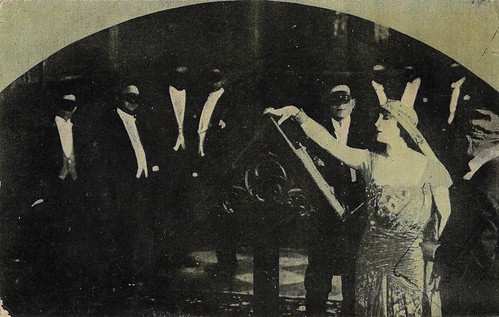
Spanish cromo by Chocolate Imperiale, no. 5 of 6 cards. Photo: Cines / distr. J. Muntañola, Barcelona. Lyda Borelli in La storia dei tredici (Carmine Gallone, 1917), after a script by Lucio D'Ambra based on Honoré de Balzac's tripartite novel 'L'histoire des treize' (1833-39), published as 'Ferragus', 'La duchesse de Langeais' and 'La fille aux yeux d'or'.

Spanish cromo by Chocolat Imperiale, Barcelona, no. 1 of 6 cards. Photo: Do-Re-Mi Film / Dist. J. Verdaguer, Barcelona. Maria Corvin aka Mary Corwyn in Napoleoncina (Lucio D'Ambra, 1918). The Spanish title of the film was Napoleoncilla.
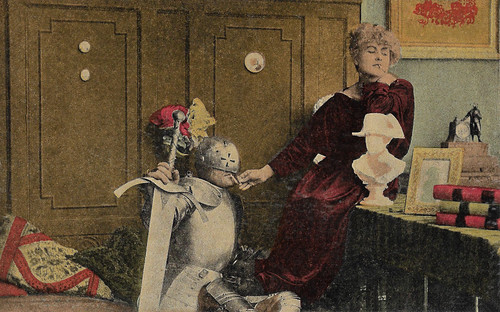
Spanish cromo by Chocolat Imperiale, Barcelona, no. 2 of 6 cromos. Photo: Do-Re-Mi Film / Dist. J. Verdaguer, Barcelona. Mary Corwyn in Napoleoncina (Lucio D'Ambra, 1918). The Spanish title of the film was Napoleoncilla.
A largely independent author and director
In 1919, in collaboration with the Piedmontese entrepreneur Alfredo Fasola, Lucio D'Ambra founded his own production company, D'Ambra-Film, with which directors Carmine Gallone, Augusto Genina and others collaborated, e.g. for Nemesis (Carmine Gallone, 1920) and La peccatrice senza peccato/Her Dreadful Secret (Augusto Genina, 1922), both starring Soava Gallone.
Yet, many films were directed by D'Ambra himself, such as Il girotondo degli undici lancieri/The round of the eleven lancers (1919) with Mary Corwyn and Romano Calò, and the witty short comedy L'illustre attrice Cicala Formica/The Illustrious Actress Cicala Formica (1920), with Lia Formia as a wannabe actress who to the frustration of her family pursues with all means to become a diva, but utterly fails. The film mocked the Italian diva and epic films, amateurism in the film world, but also the Italian family.
D'Ambra also directed serious drama, such as the Ugo Foscolo adaptation Le ultime lettere di Jacopo Ortis/The Last Letters of Jacopo Ortis (1921), on a man's despair about his inability to obtain the woman of his dreams. Until 1922 D'Ambra continued to direct and script various films at his company, often with Lia Formia in the lead, the last being Tragedia su tre carte/Tragedy on Three Cards (1922). In 1922 D'Ambra's company was absorbed into the conglomerate Unione Cinematografica Italiana and he retired from regular filmmaking. In the late 1930s, he returned but only as a screenwriter for a few films, including the comedy Occupati d’Amelia/Take Care of Amelia (Telemaco Ruggeri, 1925) starring Pina Menichelli and Marcel Lévesque.
On D'Ambra's film career, Italian scholar Gianni Rondolino wrote in the Enciclopedia Treccani: "A largely independent author and director, he was able to deal with themes and topics, situations and characters from the high society, but also from everyday life, with great fluency, in a style that took into account the linguistic peculiarities of cinema, skillfully using close-ups and camera movements, scenic effects and daring narrative solutions.
His films, considered forerunners of those of Ernst Lubitsch for the lightness of touch and the environments described, constitute a not inconsiderable chapter in the history of Italian silent films, for their formal innovation, after the more conventional splendour of the previous years, among historical reconstructions, novels of appendices, melodramas and farces." In 1937 he published his memoirs, recounting his time working in Italy's early film industry. Lucio D'Ambra died in 1939 in Rome. He was 59.
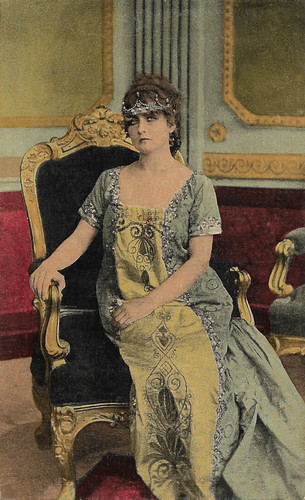
Spanish cromo by Chocolat Imperiale, Barcelona, no. 6 of 6 cards. Photo: Do-Re-Mi Film / Dist. J. Verdaguer, Barcelona. Maria Corvin aka Mary Corwyn in Napoleoncina (Lucio D'Ambra, 1918). The Spanish title of the film was Napoleoncilla.

Spanish cromo by Amattler Marca Luna chocolate, series 7, no. 1. Photo: a scene from Carnevalesca (Amleto Palermi, 1918), after Lucio D'Ambra. Photography was by Giovanni Grimaldi. Here left of the marshall we see Livio Pavanelli and Augusto Poggioli, on the back in the flowery dress, Lyda Borelli, and right of her the unknown actor who plays Pietro.
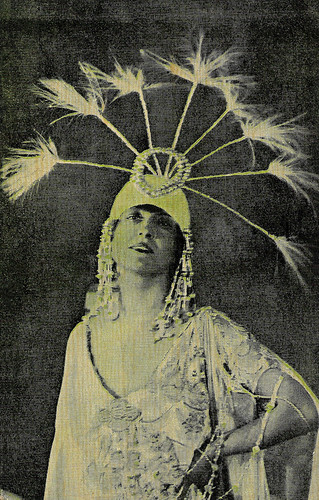
Spanish cromo by Amattler Marca Luna chocolate, series 7, no. 7. Lyda Borelli in Carnevalesca (Amleto Palermi, 1918), after Lucio D'Ambra. Photography was by Giovanni Grimaldi.

Spanish cromo by Amattler Marca Luna chocolate, series 7, no. 19. Lyda Borelli in Carnevalesca (Amleto Palermi, 1918), after Lucio D'Ambra. Photography was by Giovanni Grimaldi. On this card, Borelli's character, Queen Maria Teresa, flees the castle after having unjustly killed her husband.
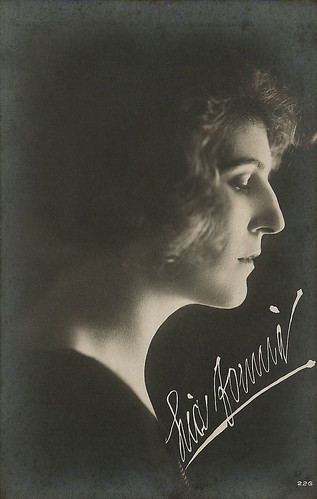
Italian postcard, no. 226. Collection: Didier Hanson. Italian actress Lia Formia appeared in 20 silent films between 1918 and 1925. For years she was the leading actress of director Lucio D'Ambra.
Sources: Gianni Rondolino (Enciclopedia Treccani), Wikipedia (Italian, French and English) and IMDb.
No comments:
Post a Comment